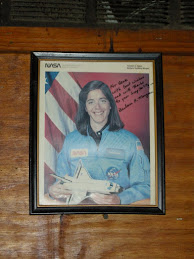Four decades after Neil Armstrong put the first footprint on the surface of the moon, NASA is planning a serious return. The last of the six American lunar missions — Apollo 17 — took place in 1972, and there is new impetus to explore the poles, far side and ancient craters of the moon as well as its potential to be a permanent launch pad for future missions, possibly deeper into space than human beings have ever gone.
This message was broadcast to the Boise State team through what looked like a trailer for a summer blockbuster. At the end, the screen flashed to black emblazoned with the words: "The Journey Begins Now." You bet it does.
The short film was followed by a digital videoconference that included representatives of Johnson Space Center, Carthage College and Boise State. NASA systems engineer Ann Bufkin kicked things off with a look at the technology she's helping developing for the Orion lander, a crew exploration vehicle that is part of the Constellation Program to send human explorers back to the moon, and then onward to Mars and other destinations in the solar system. She also talked about the vital role of the systems engineer in making sure communications specialists don't design something that's all antennas and that propulsion specialists don't make the same mistake with engines.
"You have to take folks out of their own little worlds and help them work together," Bufkin said.
Students from both schools asked questions before NASA's Dr. Carlton Allen took the virtual stage. If you boiled down his deservedly long and prestigious title, you could call him an Astromaterials Curator, but he knows about a lot more than the nearly half-ton of moon rocks and soil samples that have been brought back to earth over the years. After congratulating the teams on being accepted, he said of their impending adventure into microgravity:
"It's a whole different world. You'll be absolutely amazed when something you've been used to your whole life suddenly becomes something else."
In revisiting all of the previous moon missions, Dr. Allen explained that the infamous craters were and are caused by meteor impacts, as is the singular consistency of the lunar surface. He said the moon lacks the atmosphere that protects Earth from constant bombardment, and any plans NASA has to establish a permanent base will require engineers to address the issue in their designs and material choices. He talked about moon buggies bouncing in the air and men in 200-pound space suits jumping high to salute the flag. He talked about China, Japan and India sending spacecrafts to the moon, ushering in a new era of international exploration. He talked about NASA's plans to slam something into the moon's surface ("the 12-year-old boy way of doing science") to try to discover if ancient ice is lurking deep in craters that have never seen the sun. And he talked about the fact that all six missions were accomplished successfully using the technology of the late 1960s.
"Imagine what we'll be able to do now," Allen said. "Your generation will be the one to design, build and fly the next generation of vehicles."
Friday, March 13, 2009
Subscribe to:
Post Comments (Atom)




































No comments:
Post a Comment